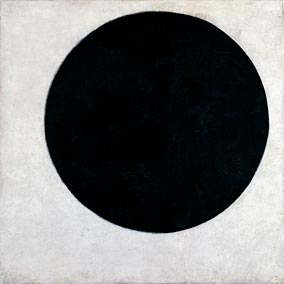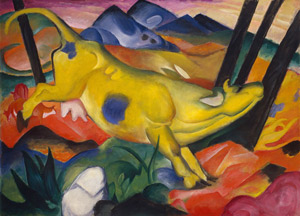Movements and Dissidents
John Haberin New York City
Malevich, Lissitzky, Malevich
Franz Marc and August Macke
In their dreams they could fly. You knew that long ago about Marc Chagall, whose men so often take to the sky. His most famous hovers at once in an indefinite foreground, above a snow-capped village, and just above distant rooftops. It has made him the paradigm of the wandering Jew, but never far from a beloved home.
Did you know that, though, about El Lissitzky, Kazimir Malevich, and Suprematism? Did Chagall's lone man with a pack on his back have a close cousin in a floating square? And did they both embody a revolutionary Soviet art? The artists taught together in Vitebsk, in present-day Belarus—the very town that Chagall knew as a child and commemorated in his painting. Now the Jewish Museum brings them together as "Malevich, Lissitzky, Malevich: The Russian Avant-Garde in Vitebsk." All, though, was not shared dreams and lasting hopes. 
Speaking of early modern encounters, with 1911 Franz Marc rang in an auspicious new year. He met that day with Wassily Kandinsky and Gabrielle Münter, Kandinsky's companion and most progressive follower. In a moment, Kandinsky's movement, the Blue Rider (or Der Blaue Reiter), had acquired an impressive base—and Marc had acquired a sense of where it could take him toward the visionary. Forthe Neue Galerie, though, it was not his first decisive meeting. The January before, although not on New Year's Day, Marc encountered August Macke, beginning a still greater friendship and closer collaboration. A show traces just that over more than three years, until World War I cost first Macke and then, in 1916, Marc their lives.
Soviet art in flight
No one should look at a black or red square by Kazimir Malevich and see only hard edges and stasis. His art soars, like work influenced by Soviet art from Mernet Larsen today, and his students at the People's Art School knew it. They sported squares on their clothing, making him the star of a provincial show. Mark Chagall had lured the older artist along Chagall's own teacher, Yuri Pen, whose colorful but conservative portraits included Chagall as well. The teacher of sculpture, David Yakerson, was churning out Suprematist studies, works on paper to honor labor and the Red Guards, and plans for a monument to a short-lived Communist uprising in Germany. And Chagall commemorated the first anniversary of the October revolution in 1918 with a thoroughly secular man in flight, as Onward, Onward.
He had returned from Paris, where he had painted the wandering Jew three years before, at the top of his game. He had absorbed Cubism, married, and celebrated the occasion with a double portrait holding a wine glass atop his bride's shoulders. He felt the freedom from the tsar's Jewish persecution, and he wanted to give something back as the region's commissar of the arts. The new school served mostly working-class Jews, and El Lissitzky, too, was Jewish. In the latter's lithographs on an ethnic folk tale, the Most Holy puts an end to a predatory cycle by slaying the angel of death. Looking at it without the titles, one might take it for a parable of worker's liberation.
Chagall like so many Soviet artists believed in the revolution. He spoke of V. I. Lenin as turning the world upside-down much as he did in paint. One could take the entire show as yet another quick and dirty run through Soviet art—like that of Soviet photography at the museum in 2016. Throw in a more popular painter on top of abstraction and hit purée. And much of the faculty dedicated itself in February 1920 to a collective, Unovis, short for "For the Affirmation of the New." Alexander Rodchenko had already coined the term Proun, for "Project for the Affirmation of the New," and now they embraced it. "The streets," they declared, "are our palettes."
Malevich was turning from painting then to theory, with "On New Systems in Art." He and others were also extending those systems to architecture and even dishware, much as the Bauhaus sought to remake art, design, and society for all. He turned out small clay models of tall towers, with brute figures just a trifle larger. Even on this scale, he took everything as larger than life. Lissitzky in turn designed a podium much like a radio tower, with Lenin in mind as its first speaker. Funny, though, how things work out.
For starters, Chagall had already departed, upset at the triumph of those floating cubes. He headed for Moscow, where he integrated his figures with geometry to protest "abstract agitprop." Then, too, a revolution is easier said than done, and Malevich had come all the way from Moscow because he needed the job. "Academicism," he declared, "is collapsing," and "no one but the provinces hangs on to it." And yet here he was in the provinces. By 1922, the Soviet Union turned on abstraction in the face of economic collapse and civil war—and the project was over, along with the affirmation of the new.
At the same time, the spiritual in Russian art lived on and not just with Wassily Kandinsky. Chagall's bride might have crushed the glass in their portrait at a proper Jewish wedding, and Ivan Puni incorporates a red violin into a painting, too—one patterned like a new nation's flag. Could it stand for a Soviet fiddler on a roof? One may never know because the curators, Angela Lampe with Claudia J. Nahson, had to cut back considerably from an installation at the Pompidou Center in Paris, leaving a show more about great ideas than great art. Ever the theorist, Malevich might be smiling after all. Then again, he often based his geometries on a cross, for an art always in flight.
Fatal encounters
In Munich, a museum for the movement traces its development, and Kandinsky seems almost a room ahead of the others every step away. No one allowed himself a greater freedom from tradition, as he adopted first washes and then geometric signs and symbols, with canvas or paper a wide-open arena for action. Still, Marc and Macke were all but born for it as painters—the first with blue horses (if not a rider) and the second with his own approach to what Kandinsky later called, in an influential book, the spiritual in art. Both exhibited with the Blue Rider starting in December 1911, after the jury for a more mainstream show had rejected a Kandinsky composition, like a late version of the Salon des Refusés that had shocked Paris with Edouard Manet. Marc and Kandinsky worked together on the cover for the second edition of the Blue Rider Almanac in 1912. By their death, Marc and Macke both approached abstraction.
 Macke admired Marc even before they met, from his lithographs, and they grew close right away. They wrote incessantly and painted one another's portrait. Macke shows his friend with a pipe, like an avuncular figure from Vincent van Gogh or Paul Cézanne and Cézanne drawing. He poses a woman with a tray of fruit out of Cézanne as well. Marc in turn was setting his wild horses, bears, and sheepdogs in feathery landscapes after Impressionism. Each was already bringing a sense of artifice and mystery to past models—from the identification of nature with wild beasts to that of women with fruit.
Macke admired Marc even before they met, from his lithographs, and they grew close right away. They wrote incessantly and painted one another's portrait. Macke shows his friend with a pipe, like an avuncular figure from Vincent van Gogh or Paul Cézanne and Cézanne drawing. He poses a woman with a tray of fruit out of Cézanne as well. Marc in turn was setting his wild horses, bears, and sheepdogs in feathery landscapes after Impressionism. Each was already bringing a sense of artifice and mystery to past models—from the identification of nature with wild beasts to that of women with fruit.
In growing together, the pair could begin to leave the last century behind, much as in the Neue Galerie today. Macke sets flowers in front of a blue mountain even before Blue Rider, and yet they still had a long way to go. Macke helps Marc flatten and sharpen his colors, while Marc helps Macke outgrow primitivism, sexism, and still life. They also move closer to a dream. For Marc, that can mean the incongruity of a yellow nude outdoors surrounded by animals. For Macke it can mean a middle-class outing in the park or by the shore, but in surreal slow motion.
They grow closer in the deepening primary colors of their main actors, set against colors that are increasingly hard even to name. They grow closer in their uncanny leaps in a seemingly shallow space, from the central action to hills or vegetation below. They grow closer in subject, too, as Marc takes up modern life and Macke farm animals. Macke will never match Marc's leaping yellow cow, with a blue blotch on its side and blue mountains in the distance. And Marc will never match Macke's concern for modern life as a solemn convocation—from strollers by a lake to four girls in the woods. Yet they increasingly share the softer brushwork and clashing color planes at the origins of abstraction.
They had plenty of help. They met Kandinsky at the home of Alexej von Jawlensky, whose bourgeois faces against shocking reds and purples were to carry him to German Expressionism. The tracery between clashing planes, akin to stained glass, has a huge debt to Paul Klee as well. And Blue Rider for a time had room for them all—as well as Arnold Schoenberg, an artist as well as composer. To bring out the crossing of personalities, media, and sensations, the curator, Vivian Endicott Barnett, plays music by Maurice Ravel in a room for works on paper. A confluence appears as metaphor in their art, too, from a forking river for Macke to birds in the snow-white waters of The Bewitched Mill for Marc.
In a show all about context, war was the final fatal encounter. Even before the impact of World War I in art, it had broken out in the Balkans. Could its threats explain darkening colors before one last burst of red, yellow, and blue? Could it explain the very need to find an escape from mundane reality into abstraction? Maybe not, given the impetus of art and artists—although it is chastening to recall that war consumed not just Macke as a young man, but also Marc well into his thirties. Kandinsky may have outpaced them, but it is chastening, too, to imagine their direction had they lived.

"Malevich, Lissitzky, Malevich" ran at the Jewish Museum through January 6, 2019, Franz Marc and August Macke at the Neue Galerie through January 21.




